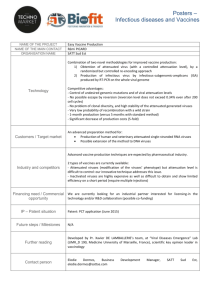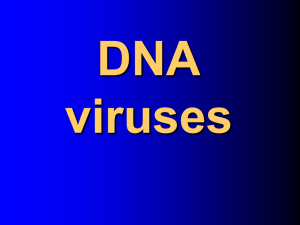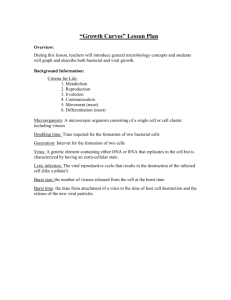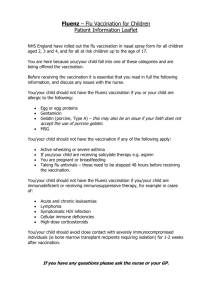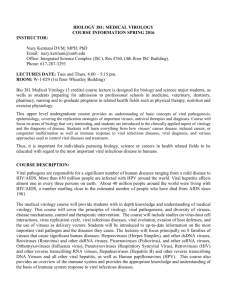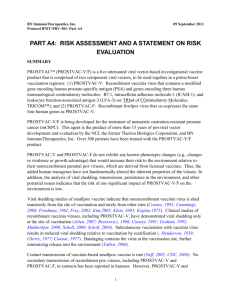Open
advertisement
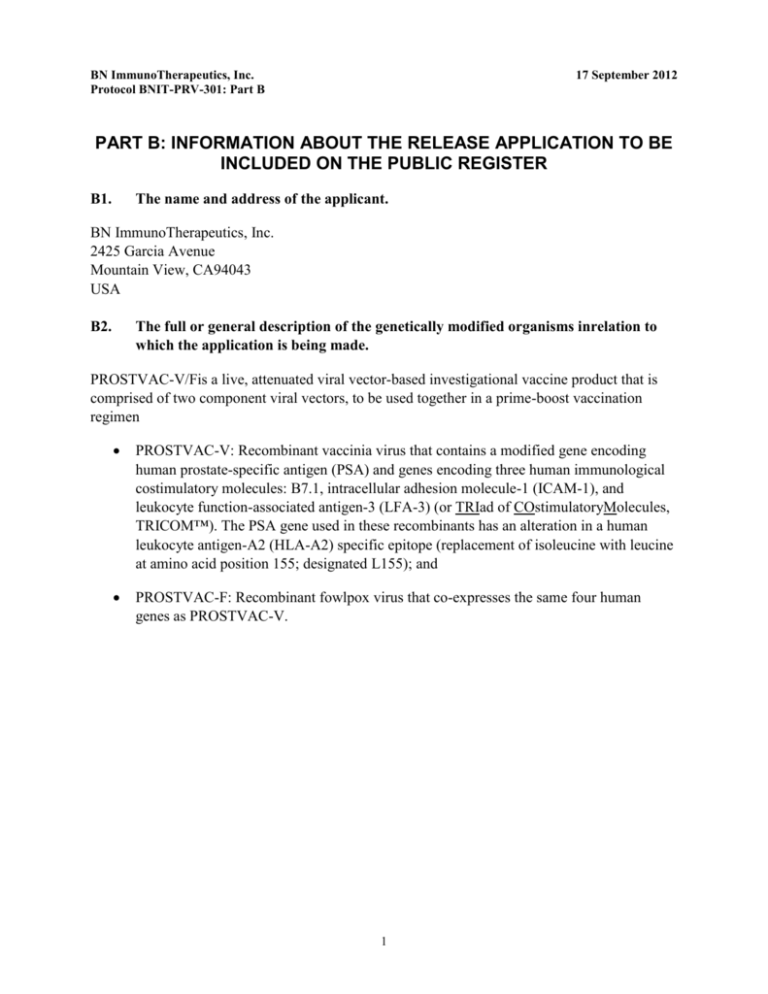
BN ImmunoTherapeutics, Inc. Protocol BNIT-PRV-301: Part B 17 September 2012 PART B: INFORMATION ABOUT THE RELEASE APPLICATION TO BE INCLUDED ON THE PUBLIC REGISTER B1. The name and address of the applicant. BN ImmunoTherapeutics, Inc. 2425 Garcia Avenue Mountain View, CA94043 USA B2. The full or general description of the genetically modified organisms inrelation to which the application is being made. PROSTVAC-V/Fis a live, attenuated viral vector-based investigational vaccine product that is comprised of two component viral vectors, to be used together in a prime-boost vaccination regimen PROSTVAC-V: Recombinant vaccinia virus that contains a modified gene encoding human prostate-specific antigen (PSA) and genes encoding three human immunological costimulatory molecules: B7.1, intracellular adhesion molecule-1 (ICAM-1), and leukocyte function-associated antigen-3 (LFA-3) (or TRIad of COstimulatoryMolecules, TRICOM™). The PSA gene used in these recombinants has an alteration in a human leukocyte antigen-A2 (HLA-A2) specific epitope (replacement of isoleucine with leucine at amino acid position 155; designated L155); and PROSTVAC-F: Recombinant fowlpox virus that co-expresses the same four human genes as PROSTVAC-V. 1 BN ImmunoTherapeutics, Inc. Protocol BNIT-PRV-301: Part B B3. 17 September 2012 The location(s) at which the genetically modified organisms will bereleased. The following clinical study site within Scotland will be used: 1 B4. Principal Investigator Address Hilary Glen M.D. Beatson West of Scotland Cancer Centre, 1053 Great Western Road, Glasgow, G12 0YN The general purpose or details of the purpose for which thegenetically modified organisms will be released. The objective of the proposed research is to confirm the safety and efficacy of PROSTVAC-V/F for the treatment of men with asymptomatic or minimally symptomatic, metastatic, castrateresistant prostate cancer in a randomized, placebo-controlled, multi-center, Phase 3 efficacy trial (BNIT-PRV-301). The study will be conducted in Australia, Belgium, Canada, Chile, , Denmark, Estonia, France, Germany, Iceland, Israel, Netherlands, , Poland, Russia, Slovakia, Spain, United Kingdom and the United States. PROSTVAC-V/F is a prostate-specific antigen (PSA) based immunotherapy strategy. It uses two non-integrating, viral vectors; a recombinant vaccinia (PROSTVAC-V) and a recombinant fowlpox (PROSTVAC-F) virus that are used sequentially in a heterologous prime-boost vaccination regimen. This enables the presentation of PSA to the patient in an inflammatory and immunogenic manner. The intent is to thereby potentially break self-tolerance and induce immune responses against this antigen that are capable of eliminating PSA-expressing cells. Prostate cancer cells express PSA while non-prostate tissue does not. Therefore the induction of anti-PSA immune responses provide a means to specifically eliminate prostate cancer cells which could provide clinical benefit and prolong survival.The PSA transgene is modified at one amino acid (I155L), to enhance binding and immunogenicity of a particular peptide epitope in HLA-A2-expressing patients.Both PROSTVAC-V and PROSTVAC-F viruses also contain three genes encoding human immunological costimulatory molecules: B7.1, intercellular adhesion molecule-1 (ICAM-1), and leukocyte function-associated antigen-3 (LFA-3) (designated TRIad of COstimulatory Molecules or TRICOM). The simultaneous expression of PSA and TRICOM enhances the immune response. The proposed clinical development of PROSTVAC-V/F addresses an unmet medical need in patients with a life-threatening disease. The treatment is being evaluated in patients with asymptomatic or minimally symptomatic castration resistant metastatic prostate cancer (mCRPC) for whom treatment options are very limited. The primary endpoint is survival. This Phase 3 study is based, in particular,on the randomized, placebo controlled Phase 2 study (TBC- 2 BN ImmunoTherapeutics, Inc. Protocol BNIT-PRV-301: Part B 17 September 2012 PRO-002), conducted in the United States under former IND 10428, which showed a potential prolongation of median overall survival when compared with empty-vector placebo control. That study in asymptomatic or minimally symptomatic metastatic disease demonstrated that (i) recombinant vaccinia and fowlpox viruses are well tolerated vectors for administration to patients with prostate cancer, and (ii) prolonged survivalwas observed in patients treated with PROSTVAC-V/F versus patients administered the control (17.7 months for empty–vector control treated patients versus 25.1 months for PROSTVAC-V/F -treated patients). B5. The foreseen dates of the release. Enrollment of study BNIT-PRV-301 began in the EU on 20th July 2012. The active treatment period for this study is approximately 5 months. The date of final release will be once approximately 3 patients have completed the active treatment period at the designated sites in Scotland (see list of sites in Section B3). B6. The methods and plans for monitoring the genetically modified organismsand for emergency response. PROSTVAC has been shown to be safe and well tolerated in a number of Phase 1 and Phase 2 clinical trials. Patients will be followed during the treatment phase of the study for any signs or symptoms of treatment-emergent toxicity by means of a focused physical exam, hematology, serum chemistry panels, EKG, and recording of AEs and concomitant medications. Study subjects will also be monitored for their immune responses following administration of vaccine through the collection of blood samples at pre-defined timepoints throughout the study. Studies that evaluatedshedding of poxviruses (including PROSTVAC-V/F) demonstrated that vaccinia viral shedding occurs transiently at the site of vaccination. Bandaging contains the virus at the vaccination site. Viral shedding does not occur at other sites, including urine, throat and blood, during the normal course of vaccination with smallpox vaccine. Rarely, viral shedding in urine and throat is observed in individuals who suffer complications after vaccination or with smallpox vaccine strains that are more pathogenic than the New York City Board of Health strain used to derive PROSTVAC-V. Moreover, subcutaneous vaccination, the intended route of administration for PROSTVAC-V, reduces the frequency of viral shedding. Similarly, shedding of avipox viruses after vaccination of non-avian species is confined to the vaccination site and is additionally limited due to lack of viral replication. No secondary transmission of recombinant poxviruses, including PROSTVAC-V and PROSTVAC-F, has been reported in humans.Consequently, no specific viral detection/monitoring relative to PROSTVAC is scheduled in the present proposal. Procedures are in place to avoid and/or minimize the spread of the GMO by controlled containment during transport and at the clinical sites and by minimizing the potential of secondary transmission to vulnerable populations through exclusion criteria defined in the study 3 BN ImmunoTherapeutics, Inc. Protocol BNIT-PRV-301: Part B 17 September 2012 protocol. In addition, patients will be educated as to the care of the injection site, including proper bandage changing, bathing, possible side effects, and minimization of contact with vulnerable populations, in order to further decrease the potential for spread and/or environmental exposure. PROSTVAC-V and PROSTVAC-Fare enveloped viruses and are rapidly inactivated by detergents and Clorox-based disinfectants. In addition to chemical agents, PROSTVAC-V and PROSTVAC-F are inactivated by exposure to ultraviolet light and by exposure increasing temperatures. When stored at 25C, these viruses are expected to lose viability over a period of weeks when stored in water, and over a period of days when stored dried. Response to accidental release of vial contents includes containment of the source of spill or leak and decontamination of affected surfaces with detergent-based cleaners or 10% Clorox. All contaminated materials will be treated as infectious waste and incinerated according to local institutional protocol. B7. The evaluations of the environmental impact of the genetically modifiedorganisms, in particular any pathogenic and/or ecologically disruptiveeffects. The release of PROSTVAC-V and PROSTVAC-F as described in this application is not expected to result in adverse environmental impact. Data that support this assessment include the following: Comparability of parental and recombinant viruses. PROSTVAC-V and PROSTVAC-F are comparable to their corresponding nonrecombinant parental viruses with respect to growth characteristics and stability in the environment. The added human transgenes have not fundamentally altered the inherent properties of the viruses. Therefore, PROSTVAC-V and PROSTVAC-F have not acquired any known phenotypic properties that would increase their risk to the environment beyond those associated with the use of the corresponding nonrecombinant parental viruses. Minimal risk of gene transfer. Poxviral replication takes place entirely in the cytoplasm; thus,PROSTVAC V/F DNA is extra-chromosomal and is not integrated. As a result, it is not subject toevents that could lead to rearrangement or recombination in the subjects participating in the study. Poxviruses are cleared from the host within several days for PROSTVAC-F and weeks for PROSTVAC-V. Minimal risk of viral shedding. Viral shedding studies of PROSTVAC-V and of related poxviruses generated using the same parental virus as PROSTVAC-V indicate that viral shedding occurs transiently at the site of vaccination. Poxviral shedding from sites other than the site of vaccination is rare and has not been reported for any recombinant poxvirus. Subcutaneous vaccination, which is the intended route of administration of 4 BN ImmunoTherapeutics, Inc. Protocol BNIT-PRV-301: Part B 17 September 2012 PROSTVAC-V, reduces the frequency of viral shedding relative to the conventional route of scarification used for vaccinia virus as smallpox vaccine. Viral shedding at the vaccination site is contained by bandaging, further minimizing release into the environment. Minimal risk of contact transmission. Contact transmission of vaccinia-based smallpox vaccine is rare. No secondary transmission of recombinant poxviruses, including PROSTVAC-V and PROSTVAC-F, has been reported in humans. Risk of transmission is reduced by use of universal precautions by healthcare workers and education of patients in proper hygiene and proper care of the vaccination site. Minimal risk of environmental persistence.Although poxviruses are relatively stable at sub-freezing temperatures, they lose viability at higher temperatures. Additionally, poxviruses are readily inactivated by a number of detergents; thus, accidental spills can be contained and are not likely to result in spread of PROSTVAC-V or PROSTVAC-F in the environment. The general environment is not likely to support propagation of these viruses, which require specific eukaryotic cells for replication, and the viruses decay at ambient temperatures. Precedent for environmental of recombinant poxviruses. Recombinant vaccinia and fowlpox viruses are currently commercially available and widely distributed in the environment as veterinary vaccines. No environmental issues associated with the use of these recombinant vaccines have been reported. 5
